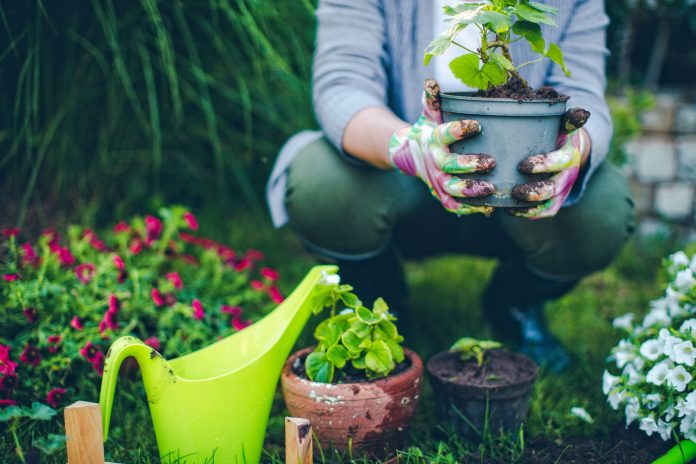Having plants at home is a fun and rewarding experience. You get to enjoy the companionship of nature being at home, and depending upon what kind of plants you have grown, each has a different kind of persona – some are decorative, some are perennial, some are seasonal, some give flowers, some give fruits and so on. Proper garden care can increase the quality and longevity of your plants, fruits, and veggies. A few hours of full sun is a must for nearly every plant, but different plant species require different levels of care. If you want your outdoor crops and beautiful flowers to withstand the seasons, it’s important to learn the right way to take care of your garden.
1.Clean up in the fall
It is always best to clean out the garden in the fall, even if you live in a moderate climate. This is not only an effective deterrent to disease but also a good way to control diseases already in your garden.
Diseases can overwinter on dead leaves and debris and attack the new leaves as they emerge in spring. Iris leaf spot, daylily leaf streak, and black spot on roses are examples of diseases that can be dramatically reduced if the dead leaves are cleared away each fall. If you are leaving stems and foliage to create winter interest, be sure to remove them before new growth starts in spring.
2.Healthy soil
Healthy soil is one of the most vital requirements of every plant. It contains essential nutrients from organic matter to micro-organisms. Soil acts as backbone for plant roots and helps support the plant to stand.
3.Apply the correct fertilizer
It’s fine to skip the fertilizer. Too much fertilizer can do more harm than good. Houseplants tend to not need fertilizer as often as outdoor plants do. If you do choose to fertilize your plant, it’s best to do so during the growing season (early spring to early fall) and follow the general rule of thumb: ‘less is more’. Most store-bought fertilizers should be diluted with water before use.
If you have had your plant for at least year, you can fertilize it for the first time. We suggest using an all-purpose fertilizer. Always follow the instructions. If you’ve just changed the soil, skip the fertilizer. Fresh soil has enough new nutrients.
4.Keep an eye on your bugs
Insect damage to plants is much more than cosmetic. Viruses and bacteria often can only enter a plant through some sort of opening, and bug damage provides that. Some insects actually act as a transport for viruses, spreading them from one plant to the next. Aphids are one of the most common carriers, and thrips spread impatiens necrotic spot virus, which has become a serious problem for commercial producers over the past 10 years. Aster yellows (photo, right) is a disease carried by leafhoppers and has a huge range of host plants. Insect attacks are another way to put a plant under stress, rendering it less likely to fend off disease.
5.Protect from animals
Set up a barrier around your garden bed, like a wire fence, to keep herbivores, critters, and other garden pests from destroying your plants. Wire fencing keeps your garden safe, while also keeping it visible and exposed to the sun (traditional fencing can sometimes block direct sunlight).
6.Raise the humidity levels
Staying true to your plants natural environment will help your plant thrive indoors. Most tropical plants, ferns and orchids prefer high humidity and bright to moderate, indirect light. Mist these plants in between waterings with filtered water. During the dry months of winter, grouping similar plants together helps to create a more humid microclimate. A humidifier can help too and it’s great for humans. On the other hand, most desert dwellers, like cacti, prefer dry air and bright, direct light with no shade at all. They definitely don’t need to be misted and don’t care for humidity all that much.
7.Prune damaged limbs at the right time
Trimming trees and shrubs in late winter is better than waiting until spring. Wounded limbs can become infected over the winter, allowing disease to become established when the plant is dormant. Late-winter pruning prevents disease from spreading to new growth. Although late-winter storms can cause new damage, it is still better to trim back a broken limb than ignore it until spring is underway. Always use sharp tools to make clean cuts that heal rapidly, and make sure to cut back to healthy, living tissue.
8.Water properly
Overwatering can lead to fungi growth, leaf spots, and unhealthy plants. Only water as often as necessary during the growing season for your specific plant species, and let the soil dry between waterings to keep from oversaturating. The trick is to keep your garden well-watered but not soaking, and avoid wetting the foliage. Water directly onto the soil instead. This is easy to do when watering by hand, but if you want to automate things, opt for a drip irrigation system rather than sprinklers.
9.Examine plants carefully before buying
The easiest way to limit disease in your garden is to avoid introducing it in the first place. Getting a disease with a new plant is not the kind of bonus that any of us wants. One of the hardest things to learn is what a healthy plant should look like, making it difficult to know if the one you want is sick.
It is a good idea to collect a few books, magazines, and catalogs that show what a healthy specimen looks like. Don’t take home a plant with dead spots, rotted stems, or insects. These problems can easily spread to your healthy plants and are sometimes hard to get rid of once established.
10.Use fully composted yard waste
Not all materials in a compost pile decompose at the same rate. Some materials may have degraded sufficiently to be put in the garden, while others have not. Thorough composting generates high temperatures for extended lengths of time, which actually kill any pathogens in the material. Infected plant debris that has not undergone this process will reintroduce potential diseases into your garden. If you are not sure of the conditions of your compost pile, you should avoid using yard waste as mulch under sensitive plants and avoid including possibly infected debris in your pile.
































